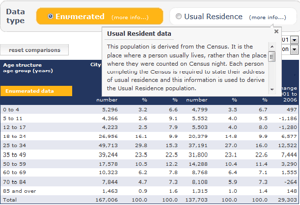One of the most common questions we are asked about Census data is whether it’s best to use Enumerated or Usual Residence data when making statements about populations. Our Census product, profile.id, gives users the option to use either, with both options prominently displayed with radio buttons to select at the top of each table. But which should you use?

Firstly, a bit of background
Census in Australia has normally been collected on a “place of enumeration” basis. This means that wherever you’re staying on Census night, that’s where you fill in a form and are counted. This is the best way of ensuring everyone is captured (since in Australia the government doesn’t have the power to order people to return to their homes for Census,which would just make things a whole lot easier!)
Since the early 1980s, however, the Census form has also asked “Where was the person’s usual address?”, to be filled in if they are counted away from home (95% of people are counted at home anyway so we are only talking about tinkering around the edges here). This makes it feasible to put people back in their Census Collection District of usual residence, and in 2006 this was made the standard output method for ABS.
In effect, this creates two different populations and two different sets of data. The Enumerated data set is a count of where people were on Census night. The Usual Residence data set records where people usually live. This leads to a lot of questions about which one to use.
Advantages of using Usual Residence data
There are some clear advantages to using Census data based on place of Usual Residence:
- You are dealing with only the residents of the area, not the visitors – most councils are concerned foremost with providing services to their residents.
- You bring back all the residents who were away from home on Census night – note however that this only includes people who were in Australia and counted in the Census – people overseas on the night still aren’t brought back by this count.
- You have comparability to the data on the ABS website released for the 2006 Census.
- You usually get a figure closer to the “Estimated Resident Population” which is yet another population type and the official population of the area updated each year.
Disadvantages of using Usual Residence data
There are some drawbacks to using UR data, however:
- Only 2001 and 2006 time series comparison is available. You can’t go back further because the info wasn’t collected prior to the 2001 Census. This will become less of a concern once the 2011 data is out as then we’ll have 3 Census years by usual residence.
- The coding is not good enough to give you information on anything to do with dwellings or households, which must be counted where they were on Census night. You’ll notice that if you switch from a person topic using UR, to a dwelling or household topic (eg. “Are we owners, renters or buyers?”), profile.id switches back to Enumerated mode.
Some examples
It can make quite a difference to the total population numbers, depending which one you choose. In most areas, Usual Resident population is a bit higher than Enumerated population. Check out the difference for Sutherland Shire, NSW where switching to Usual Residence adds about 3,000 people to the population.
The other thing you might notice is that in many areas, this one included, the population increase from 2001 to 2006 is higher when you select Usual Residence than when you select Enumerated population. This means that more people were away from the area in 2006 than in 2001. We think this may be due to the increasing “grey nomad” phenomenon, as it is particularly apparent in areas with older populations, such as Bass Coast in Victoria.
Our recommendation
Generally, our recommendation is that if you need to quote a single number for the population of a suburb or town, use the Usual Residence figure.
If you’re quoting the official population for a Local Government Area, use the current Estimated Resident Population (we haven’t discussed the population here), which appears on the front page of our community profiles, as it’s more up-to-date.
If you need to look at the characteristics of a population, with comparisons to benchmarks, which is what our community profiles are designed to do, stick with Enumerated population for the moment, as it’s more straightforward, all topics are comparable and you can get a longer time series. The exceptions are if you are in one of those areas which has a higher Enumerated population than Usual Residence. These include coastal areas of:
- Queensland (see the difference for Surfers Paradise which loses 7,000 people when switching from enumerated to usual residence)
- Snowfields in Victoria and NSW (not profiled at the moment) and;
- CBD areas such as the City of Sydney. For these areas, you can explore two quite different populations by using the enumerated and usual residence options judiciously, and the one you use will really depend on the story you are telling.
Final note
Remember that enumerated is a “real” population in the sense that it actually happened at a point in time, while usual residence is more theoretical as there is never a day when everyone is at home.
Remember, if you’re ever stuck or not sure which population you should be using, feel free to contact us at .id, by phone or email. We’re here to assist with any of your demographic questions. If you found this information helpful, please share it with your colleagues.
.id is a team of demographers, population forecasters, spatial planners, urban economists, and data experts who use a unique combination of online tools and consulting to help governments and organisations understand their local areas. Access our free demographic resources here










